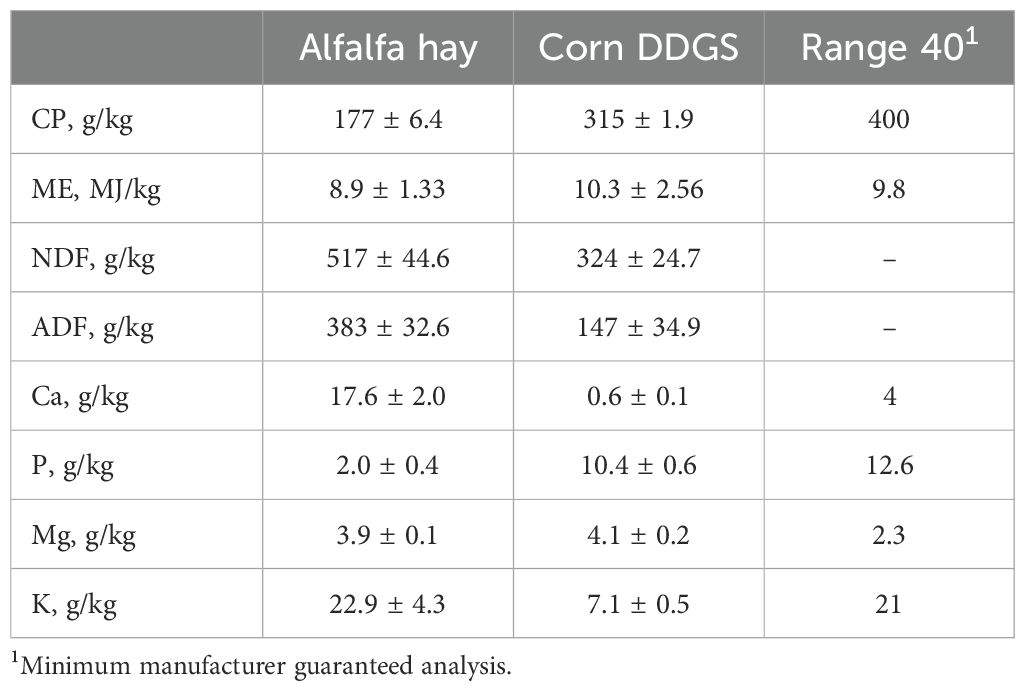- 1Central Grasslands Research Extension Center, North Dakota State University, Streeter, ND, United States
- 2School of Natural Resource Sciences, Range Science Program, North Dakota State University, Fargo, ND, United States
- 3Business and Trades Technology Department, Williston State College, Williston, ND, United States
Introduction: Beef cattle in the Northern Great Plains of the United States of America are normally kept in open dry lot pens in winter. Practices such as bale grazing, swath grazing, stockpiling, and corn residue grazing, can be used to extend the grazing season and minimize dry lot use. Extending the grazing season has several advantages over dry lot use but arguably the most important benefit is cost savings due to lower labor and input costs. Strategies selected to supplement cattle in extended grazing systems should maintain cost savings while providing required nutrients to cattle. This study was conducted to evaluate supplementing strategies for beef cattle in a bale grazing system using grass hay during variable winter conditions. The study was conducted across variable winter conditions that are encountered in winters in the US Northern Great Plains.
Methods: The study extended over four years. Each year, non-lactating pregnant beef cows (n = 64, year 1; n = 80, year 2, 3, 4) were divided into eight groups of similar average body weight and randomly assigned to one of four bale grazing treatments as follows: a) bale grazing grass hay, b) bale grazing grass hay treated with a liquid supplement, c) bale grazing grass hay and alfalfa hay, and d) bale grazing grass hay and plus 1.8 kg corn DDGS/head/day. Animal performance was assessed from two-day body weights and body condition scores taken at the start and end of the study. Data analysis considered the fixed effects of treatment, year, and treatment x year interaction.
Results: Final BW tended (P = 0.09) to be greatest following corn DDGS supplementation and lowest when grass hay was offered. The treatment strategy x year interaction (P = 0.026) for ADG showed that corn DDGS supplementation resulted in positive ADG across the years regardless of environmental conditions. Liquid or alfalfa hay supplementation resulted in positive ADG when environmental conditions were favorable. Final BCS (P = 0.005) and BCS change (P = 0.004) were greater following corn DDGS supplementation, intermediate following alfalfa hay or liquid supplementation and lowest when grass hay was fed. Supplementation costs ranged from $1.33 to $1.90/head/day, the highest cost occurred with corn DDGS supplementation mainly due to cost of corn DDGS and labor required to deliver corn DDGS to cattle on pasture.
Discussion: Alfalfa hay or molasses-based liquids increased diet CP content but did not supply adequate energy in severely cold winters. Despite relatively higher supplement costs, high energy supplements such as corn DDGS may be required in severely cold winters where cattle require extra energy. Supplement selection should consider supplement effectiveness to meet animal nutrient requirements particularly in adverse winter conditions such as those encountered in the US Northern Great Plains.
1 Introduction
Cattle in the US Northern Great Plains are normally kept in open dry lot pens in winter (Asem-Hiablie et al., 2016), a practice associated with high winter feed costs. Alternatively, dry lot use can be minimized by extending the grazing season through strategies such as bale grazing, swath grazing, stockpiling, and grazing corn residue. Bale grazing is a practice of placing hay bales in a grid pattern on hayfields or pastures for grazing in the fall and winter (McGeough et al., 2018). Benefits of extending the grazing season include returning nutrients directly onto land to optimize nutrient capture by growing plants, minimizing nutrient loss through runoff or leaching (Jungnitsch et al., 2011; Bernier et al., 2014), and reducing farm greenhouse gas emissions (Alemu et al., 2016). More importantly, lower labor and input costs associated with extended grazing can decrease production costs and potentially enhance profitability of livestock production.
Forages utilized for bale grazing are predominantly perennial in nature, mainly grasses and grass-legume mixtures although straw may also be utilized (McGeough et al., 2018). In situations where cattle are offered low-quality grass hay or straw, supplementation may be required to meet cattle nutrient requirements. Supplementation becomes especially critical during harsh winter conditions such as those encountered in the Northern Plains. Supplementation is expensive due to costs associated with cost of supplement, labor, and equipment associated with supplement delivery (Cappellozza et al., 2013). Since extended grazing systems are predicated on lower winter feed costs relative to dry lot feeding, supplementation strategies selected for these systems should maintain cost savings while providing targeted amount of required nutrients. Cost savings can be maintained through strategies that either reduce frequency of supplement delivery to cattle on pasture or eliminate pasture visits for supplementation purposes altogether.
For supplements such as corn DDGS, which have to be delivered to cattle on pasture, supplementation costs can be minimized by decreasing labor and equipment inputs through reducing frequency of supplementation (Wickersham et al., 2008). However, less frequent supplement delivery can only be justified if grazing animals continue to consume forage and maintain good nutrient status (Schauer et al., 2005). Also, less frequent supplement delivery can reduce competition for supplement when greater quantities are provided in a single setting (DelCurto et al., 2000). Previous studies (Schauer et al., 2005; Loy et al., 2007; Cappellozza et al., 2013) have shown that less frequent supplement delivery does not negatively impact animal performance and can decrease costs associated with supplementation. Pasture visits for supplementation purposes may be eliminated by supplying high-quality forage to complement low-quality forage or treating low-quality forage with molasses-based liquid supplements. Alfalfa hay (DelCurto et al., 1990; Vanzant and Cochran, 1994; Horney et al., 1996; Weder et al., 1999) and good-quality grass hay (Horney et al., 1996; Villalobos et al., 1997) have been utilized to complement cattle grazing low-quality pastures. Liquid supplements poured directly onto hay can reduce hay waste, improve hay storage, and improve nutrient content of low-quality forage (Walker et al., 2013; Warner et al., 2015). Currently, there is limited information on strategies for supplementing cattle in extended grazing systems. This study was conducted to evaluate supplementing strategies for beef cattle in a bale grazing system using grass hay during variable winter conditions. The study was conducted across variable winter conditions that are encountered in winters in the US Northern Great Plains.
2 Materials and methods
2.1 Ethics statement
Animal handling and care procedures were approved by the North Dakota State University (NDSU) Animal Care and Use Committee.
2.2 Study site
This study was conducted at the North Dakota State University, Central Grasslands Research Extension Center, located in Stutsman and Kidder counties northwest of Streeter, North Dakota, USA (46°45′N, 99°28′W). Soils at the site are Lihen-Telfer loamy fine sands (57.6%), Krem-Flaxton complex (28.4%), Williams-Bowbells loams (9.3%), and Hecla-Ulen loamy fine sands (5.6%; U.S. Department of Agriculture, Natural Resources Conservation Service (NRCS), 2021). The soils are classified as moderately to well-drained loamy soils with a slope of 0 to 6% (U.S. Department of Agriculture, Natural Resources Conservation Service (NRCS), 2021).
2.3 Hay treatments
A 10.5-ha field was divided into 8, 1.3-ha paddocks separated with three-strand, high-tensile wire electric fencing. A 1000-L tire tank was installed between two paddocks to supply fresh water. Two 7m x 2.5m portable windbreaks, made of solid metal sheets, were placed in a V-shape in each paddock and tied together to protect livestock from the northwestern wind. Round hay bales were placed into paddocks in a 2 x 2 grid pattern with approximately 15m between bales in the fall of each year. The bales were placed in an upright position and net wrap was removed prior to feeding. Every forth bale was pre-weighed before placement in paddocks. Grass hay bales were obtained from a field of mixed cool-season grasses that had not been harvested for several years. Predominant grasses in the field were intermediate wheatgrass (Thinopyrum intermedium L.) and tall wheatgrass (Thinopyrum ponticum L.). Hay used in all treatments was obtained from the same field which made hay quality comparable across treatments. Each year, hay bales were subsampled and analyzed for nutrient composition prior to bale grazing.
Four bale grazing treatments (two paddocks/treatment) were set up as follows: a) bale grazing grass hay, bale grazing grass hay treated with a liquid supplement, c) bale grazing grass hay and alfalfa hay, and d) bale grazing grass hay plus corn DDGS. Liquid supplementation involved pouring a molasses-based liquid supplement, Range-40 (QLF Inc., Dodgeville, WI), onto grass hay bales at a rate of approximately 10% of average bale weight. With an average bale weight of 543kg, approximately 54kg of liquid supplement was added to grass hay bales. The required rate of dispensing liquid supplement onto bales was estimated from time required to dispense a known amount of liquid supplement into a container of known volume. Timing of liquid supplement dispensation was checked regularly to ensure that the rate remained similar among bales. Poured bales were allowed to sit upright until liquid supplement had seeped through the bale and then were flipped on their side. Supplementation with alfalfa hay was accomplished by providing one bale of alfalfa hay for every three bales of grass hay fed during each feeding cycle. Corn DDGS was delivered twice weekly to cattle on pasture and fed in bunks to provide 1.8 kg corn DDGS/head/day.
2.4 Animal study
The study extended over four years. Each year, non-lactating pregnant Angus-cross beef cows (year 1, n = 64, BW = 592 ± 64 kg, parity = 3.1 ± 0.87; year 2, n = 80, 617 ± 59 kg, parity = 3.4 ± 1.13; year 3, n = 80, 635 ± 45 kg, parity = 3.4 ± 1.24; year 4, n = 80, 615 ± 30 kg, parity = 3.7 ± 0.99) were divided into eight groups of similar average body weight and randomly assigned to treatments. Bale grazing generally commenced in mid-November of each year until January except in year 2, when grazing started earlier. Duration of grazing was 70d, 66d, 67d, and 65d for year 1, 2, 3, and 4, respectively. Cows had access to four hay bales at a time and access to a new set of four bales was controlled using a portable electric wire. Cows were moved to a new set of bales when it was visually estimated that at least 20% of the original hay weight from each bale was remaining. Cows had ad libitum access to fresh water, commercial mineral supplement (Purina Animal Nutrition, Shoreview, MN), and a salt block (NaCl, 98% minimum guaranteed analysis, American Stockman). Cow performance was assessed from two-day body weights (BW) and body condition scores (BCS) taken at the start and end of the study. Body condition scores were assigned by two trained technicians working independently using a 9-point system (1 = emaciated, 9 = obese; Rasby et al., 2014). Body weight data were adjusted for fetal tissue weight before statistical analysis. Fetal tissue weight was predicted from actual calf birth weight (CBW) and day of pregnancy (t) at time of weighing (NASEM, 2016) as follows:
Dry matter intake (DMI) was estimated from a modification of the forage disappearance technique described by Kelln et al. (2011) which calculates DMI from the weight difference between fed forage and residual forage accounting for number of days on feed. Use of the forage disappearance technique to estimate DMI depends on successful separation of soil and fecal matter from residual forage. In this study, it was impossible to effectively separate soil and fecal matter from residual forage thus, a 20% hay wastage value (Jaderborg et al., 2021) was adopted to estimate residual forage. Crude protein (CP) and metabolizable energy (ME) intakes were calculated from forage DMI considering diet CP and ME content, respectively.
2.5 Feed sampling and analysis
Grass hay, liquid-treated grass hay, and alfalfa hay bales were core-sampled (four cores per bale) using a hand-held electric Penn State core sampler. Samples were dried in a forced-air oven at 60°C for at least 48 h and then ground through a Wiley mill (1-mm screen; Arthur H. Thomas, Philadelphia, PA). Samples were submitted to Dairyland Laboratories (Dairyland Laboratories Inc., St. Cloud, MN) for chemical analysis. Samples were further dried at 100°C for 24 h to determine total dry matter (DM; Association of Official Analytical Chemists (AOAC), 2005; method 930.15). Crude protein (CP) was determined using a LECO 628 analyzer (LECO Corporation, St. Joseph, MI; AOAC Method 990.03). Neutral detergent fiber (NDF; AOAC; method 2002.4) and acid detergent fiber (ADF; AOAC; method 973.18) were determined using an ANKOM Fiber Analyzer (ANKOM Technology Corporation, Macedon, NY). Concentrations of Ca, P, K, Mg, and S were determined by inductively-coupled plasma emission spectroscopy (AOAC; method no. 985.01).
2.6 Statistical analysis
Animal performance data were analyzed using the MIXED procedure of SAS (version 9.4; SAS Institute Inc, 2008) with paddock as the experimental unit. The fixed effects in the model were treatment, year, and treatment × year interaction. The effects of cow within treatment were considered random. Least square means were calculated and, where appropriate, differences among treatment means were tested using the Bonferroni test at a significance level of P ≤ 0.05. Average daily gain (ADG) was calculated as the difference between initial weight and end weight divided by the number of bale grazing days. Change in BCS was calculated as the difference between initial BCS and final BCS.
2.7 Nutrient requirements
Nutrient requirements of beef cattle determined under standardized conditions are applied indiscriminately to an infinite combination of animal, management and environmental conditions (Fox et al., 1988). The requirements are typically estimated based on the assumption that animals are fed under ideal conditions with little or no environmental stress, and therefore should perform to their genetic potential (Abney and Galyean, 2006). Bale grazing cattle in the US Northern Great Plains are exposed to cold temperatures, low wind chills, freezing rain and snow. To evaluate supplementation strategies under conditions encountered in the US Northern Great Plains, the NASEM (2016) Beef Cattle Nutrient Requirements Model (BCNRM) was used to predict metabolizable energy (ME) and metabolizable protein (MP) requirements and supply for cows kept in environmental temperatures encountered in this study. Monthly average temperatures encountered in this study are shown in Table 1 (North Dakota Agricultural Weather Network, 2021). The first year was marked by below-average temperatures particularly in December and January. Temperatures in year 2 were milder relative to all other years because grazing commenced earlier. The third and fourth years were similar and colder relative to year 2 but warmer than year 1. The 2016 NASEM model was used to compare energy and protein balance in cows kept in various supplementation strategies over the years. Energy and protein balance were calculated as the difference between dietary energy or protein supply and energy or protein requirement. The 2016 NASEM model was also used to compare adequacy of supplementation strategies across the years. This was accomplished by adopting year 3 liquid supplementation as the baseline and comparing this baseline to supplementation strategies in year 1, 2, and 4, designated as severe, mild, and moderate, respectively. For this purpose, relative energy intake (%) was calculated by comparing ME intake from each supplementation strategy in years 1, 2, and 3 to ME intake from liquid-supplement hay in year 3, the baseline year.
2.8 Supplementation costs
Prices of corn DDGS, liquid supplement, grass and alfalfa hay were obtained from a local farm input supplier (Farmers Coop Elevator Company, Streeter, N.D.) The price grass and alfalfa hay of $60 and $80/MT, respectively, included the cost of purchasing and hauling the hay to the bale grazing site. Corn DDGS and liquid supplement were priced at $255 and $319/MT, respectively. Labor ($19/h) included time for placing portable windbreaks at the start of the study, moving portable electric wire to allow access to new feed, twice weekly visits to feed corn DDGS, and hauling water to the site.
3 Results
The supplements fed in this study are shown in Table 2. Alfalfa hay and corn DDGS contained 17.7 and 31.3% CP and 8.9 and 10.3 MJ/kg ME. The liquid supplement contained 40% CP and 9.8 MJ/kg ME (Table 2). Grass hay fed over four years averaged 79 g/kg CP with an ME concentration of 7.3 MJ/kg (Table 3). Addition of a liquid supplement to grass hay increased ME and CP by 8% and 14%, respectively (Table 3). Supplementation with alfalfa hay increased ME and CP concentration by 5% and 38%, respectively. The highest increase occurred with corn DDGS supplementation, increasing ME and CP concentration by 11% and 44%, respectively (Table 3).
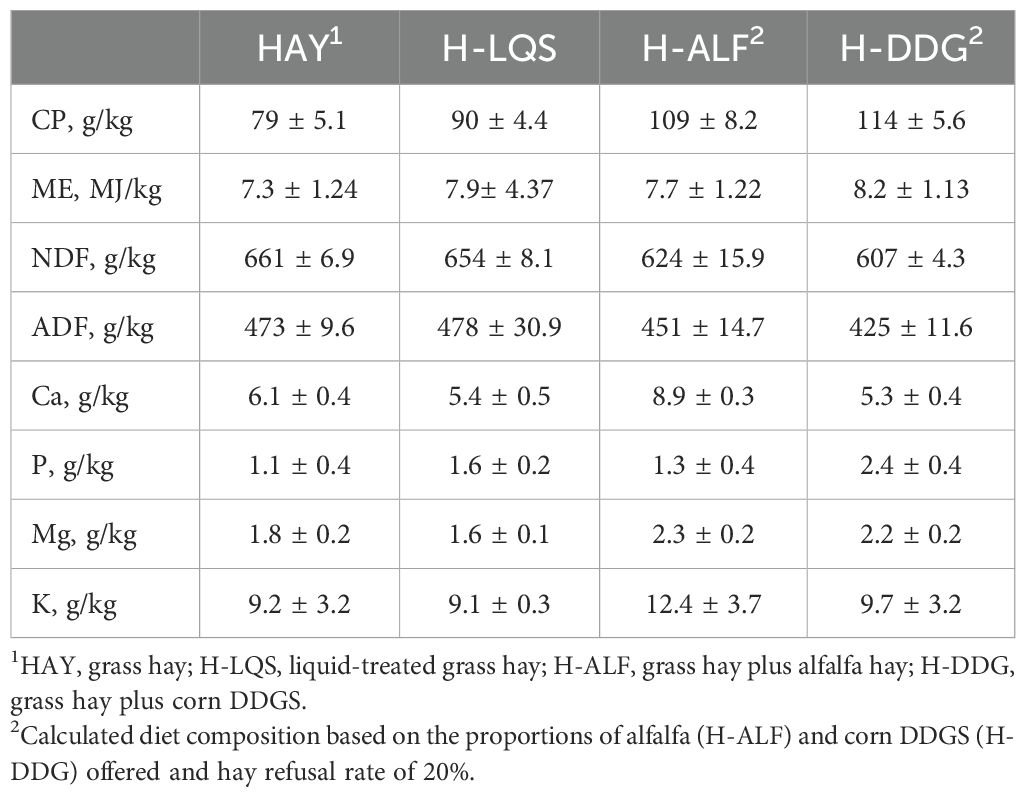
Table 3. Chemical composition (mean ± SD; % DM) of grass hay, or grass hay supplemented with a liquid, alfalfa hay, or corn DDGS.
Dry matter intake was greater (P ≤ 0.001) following corn DDGS supplementation (Table 4) because DDGS-supplemented cows received 1.8 kg corn DDGS/head/day in addition to grass hay. As a percent of BW, DMI was greater (P ≤ 0.001) following corn DDGS supplementation relative to other treatments. Crude protein intake was influenced by treatment and year (P ≤ 0.001; Table 4) and was greatest following corn DDGS supplementation and lowest when only grass hay was fed. Energy intake was influenced by treatment and year (P ≤ 0.001; Table 4) and was consistently greater following corn DDGS supplementation relative to alfalfa hay, liquid supplement or grass hay (Figure 1).
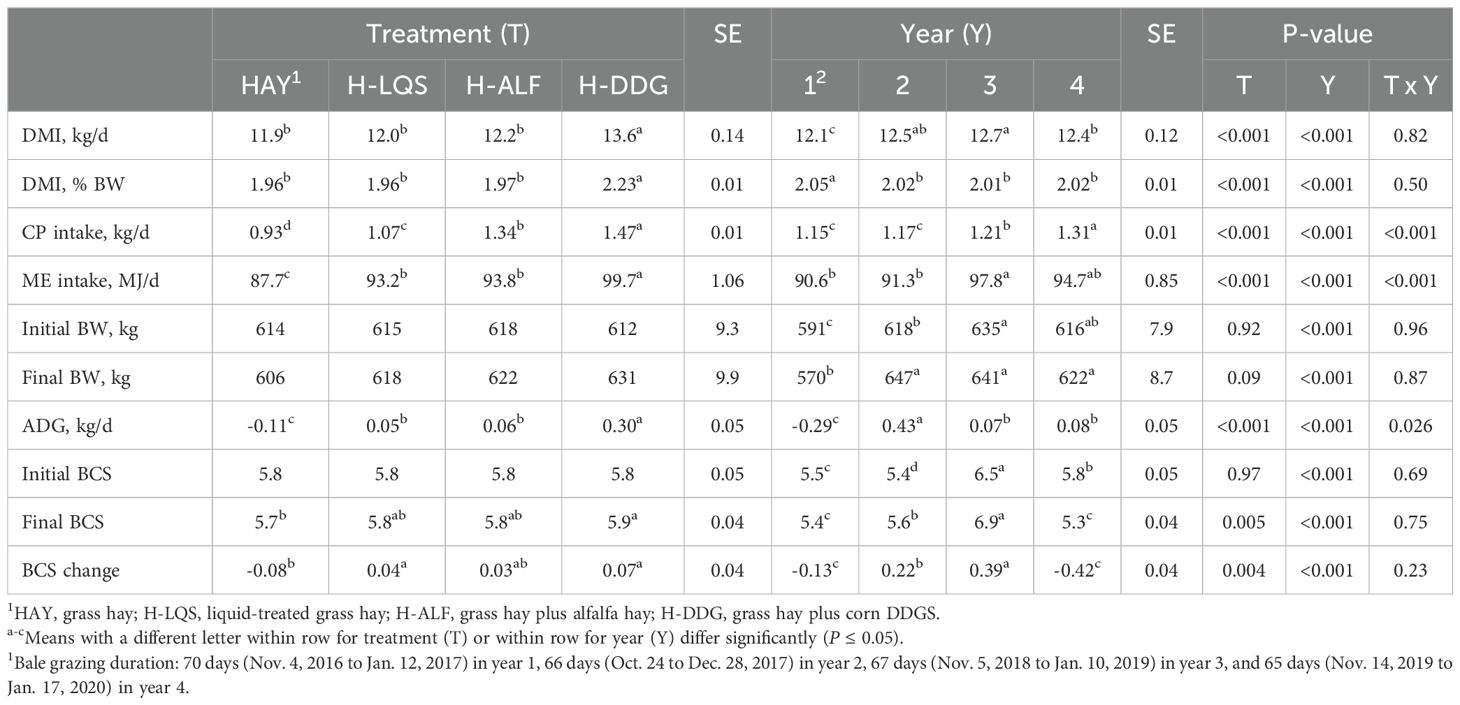
Table 4. Cow performance following bale-grazing of grass hay, or grass hay supplemented with a liquid, alfalfa hay, or corn DDGS.
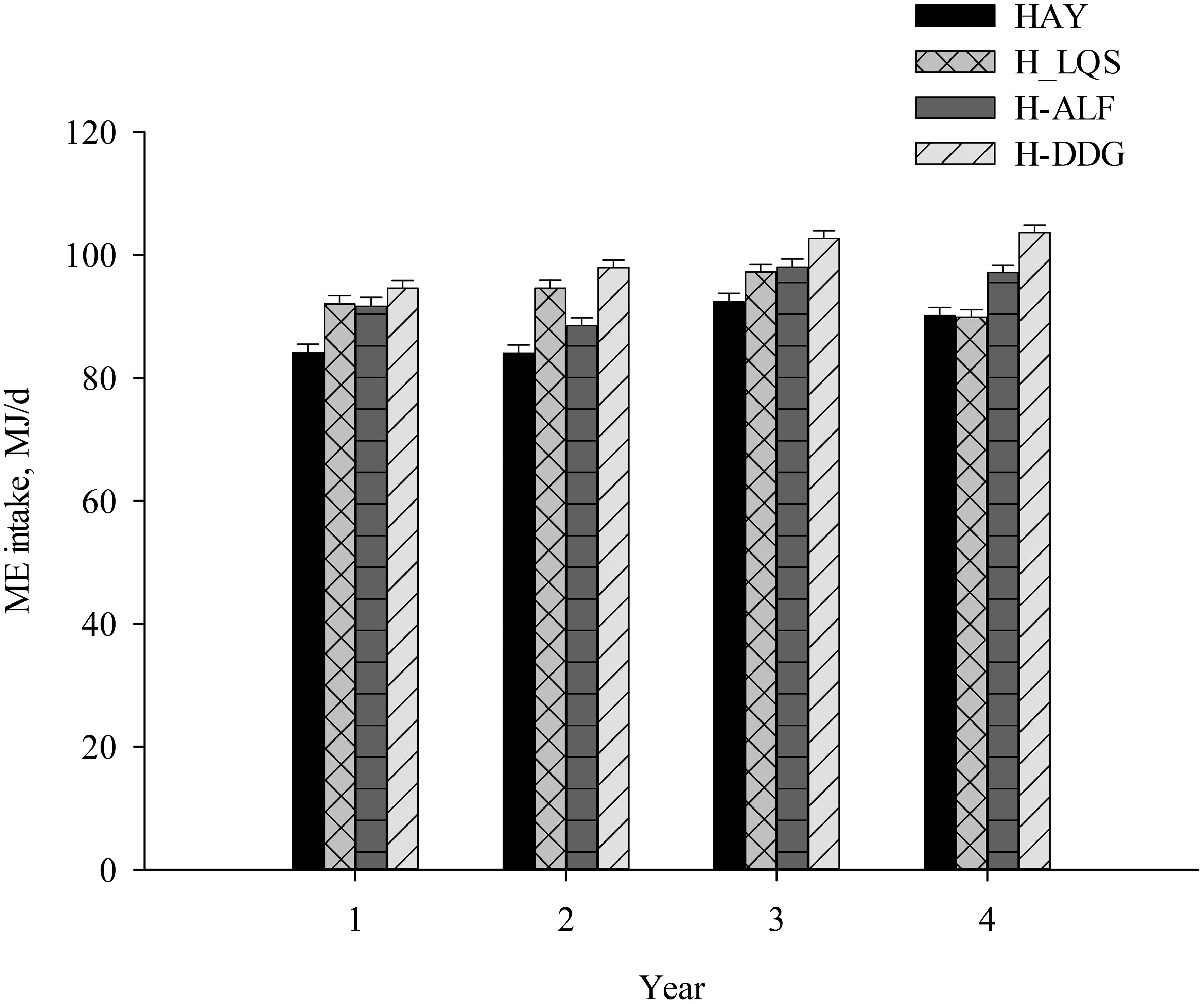
Figure 1. Energy (MJ/day ME) intake by cows bale grazing grass hay (HAY) or liquid-treated grass hay (H-LQS), grass hay plus alfalfa hay (H-ALF), or grass hay plus corn DDGS (H-DDG).
By design, there was no difference (P = 0.92) among treatments in initial cow BW but there were differences (P ≤ 0.001) among the years (Table 4). Final BW tended (P = 0.09) to be greatest following corn DDGS supplementation and lowest when only grass hay was offered (Table 4). Average daily gain was influenced by treatment and year (P = 0.026; Table 4). Corn DDGS supplementation resulted in positive ADG across the years regardless of environmental conditions (Figure 2). In year 2, supplementation strategies improved ADG above bale grazing grass hay only. As well, cows gained weight in year 2 probably due to more favorable environmental conditions (Figure 2). In year 3 and 4, ADG were minimal following bale grazing grass hay, liquid-supplemented hay or alfalfa hay (Figure 2). There was no difference (P = 0.97) among treatments in initial BCS but there were differences (P ≤ 0.001) among years (Table 4). Final BCS was greater (P = 0.005) following corn DDGS supplementation, intermediate following alfalfa hay or liquid supplementation and lowest in cows fed grass hay only (Table 4). Final BCS differed (P ≤ 0.001) on a yearly basis. Change in BCS was greater (P = 0.004) following corn DDGS supplementation, alfalfa hay or liquid supplementation and lowest when cows were fed only grass hay.
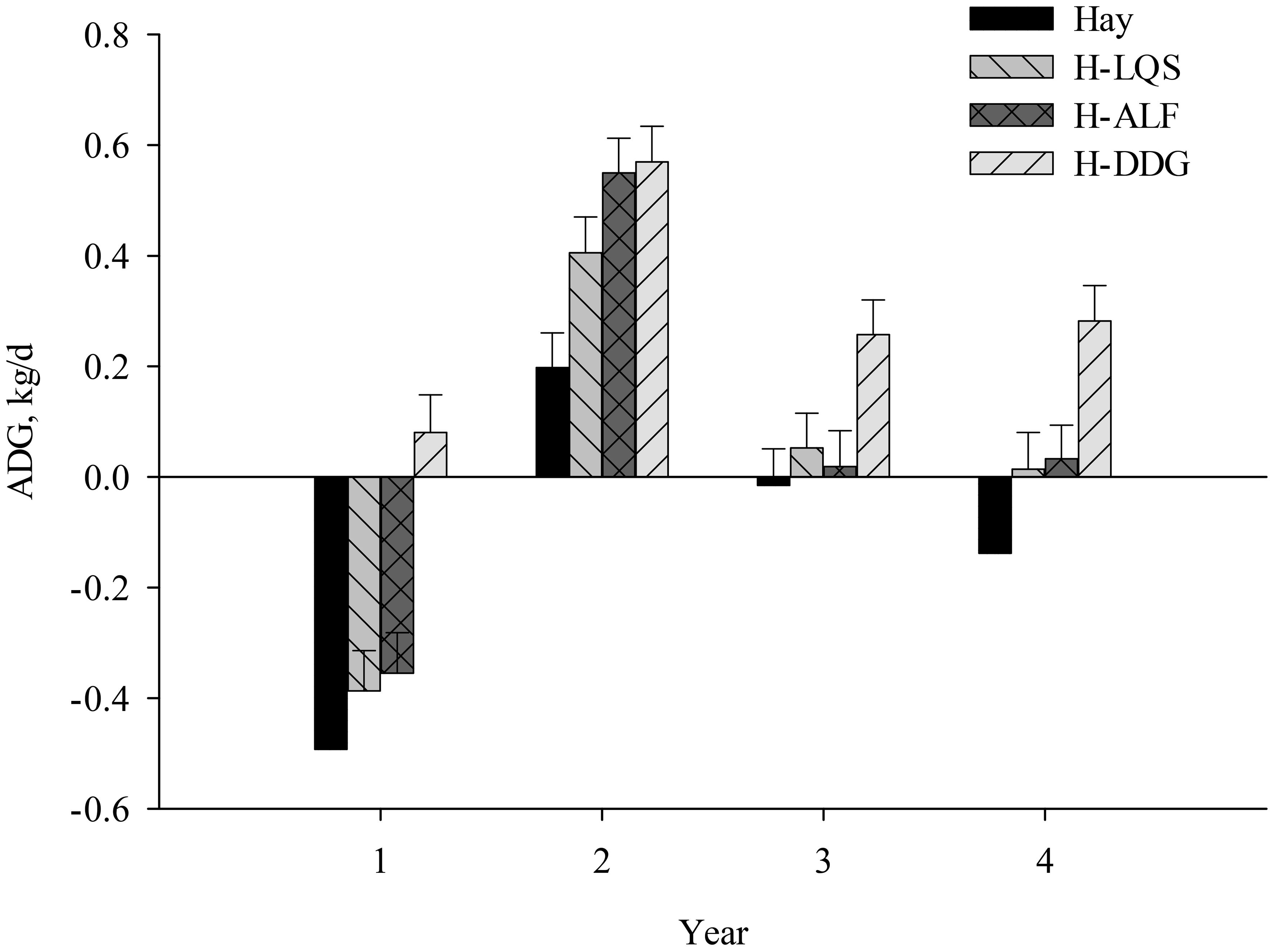
Figure 2. Average daily gains of cows bale grazing grass hay (HAY) or liquid-treated grass hay (H-LQS), grass hay plus alfalfa hay (H-ALF), or grass hay plus corn DDGS (H-DDG).
4 Discussion
Grass hay provided adequate MP to meet protein requirements of non-lactating beef cows in the second trimester of pregnancy in all environmental conditions encountered in the study. Positive MP balance across four years of the study (Figure 3) suggest that there was no apparent need for protein supplementation. Grass hay, however, did not provide adequate energy to meet daily ME requirements for non-lactating beef cows in the second trimester of pregnancy in environmental conditions encountered in this study. Based on the 2016 NASEM model, feeding grass hay only resulted in negative energy balance across all study years (Figure 4), suggesting a need for supplementing cattle even in mild weather conditions as occurred in year 2. This is further supported by weight loss by cows bale grazing grass hay in all environmental conditions encountered in this study.
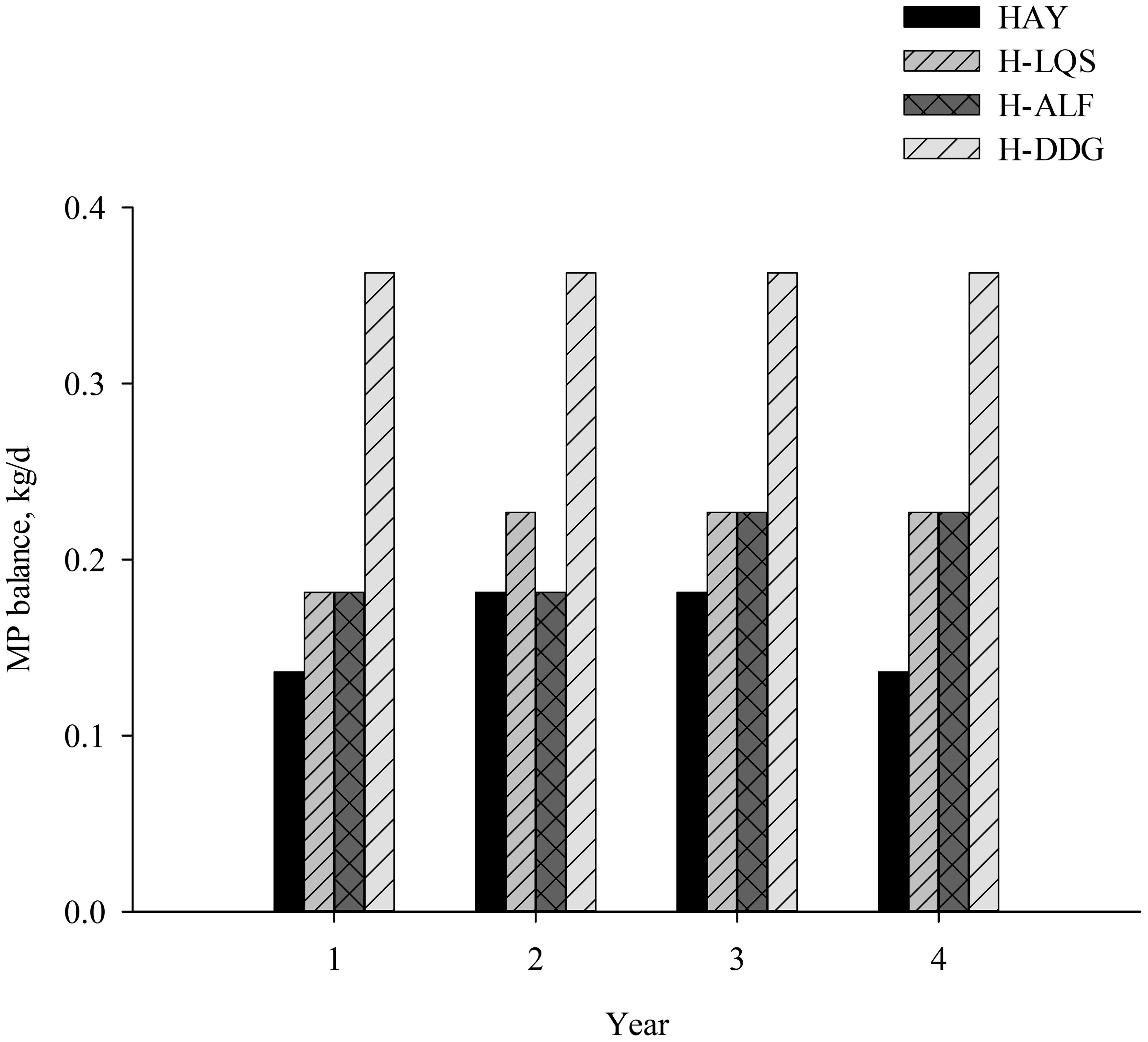
Figure 3. Predicted MP balance (dietary MP supply – MP requirements, kg/d) in cattle grazing grass hay (HAY) or liquid-treated grass hay (H-LQS), grass hay plus alfalfa hay (H-ALF), or grass hay plus corn DDGS (H-DDG).
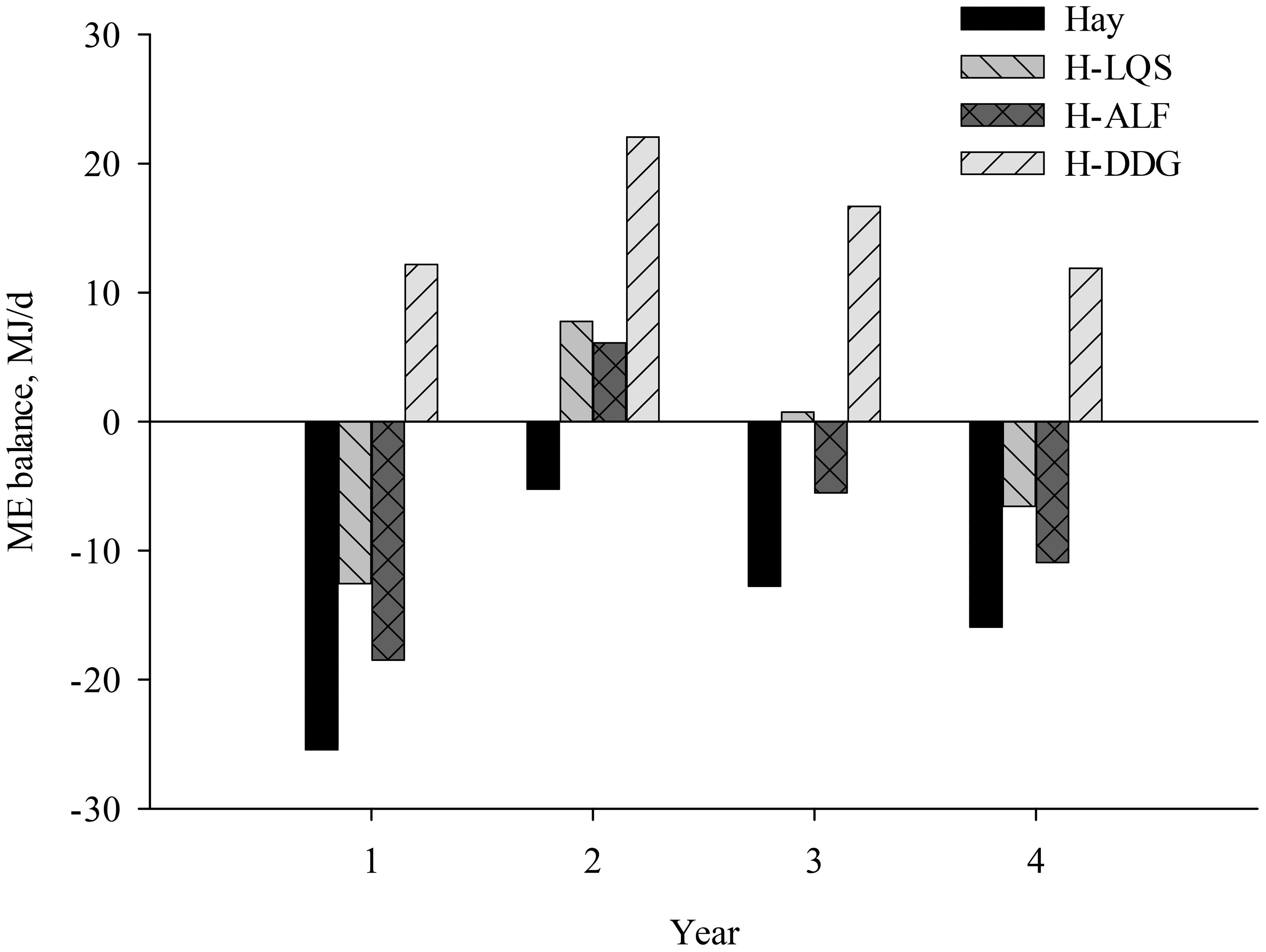
Figure 4. Predicted ME balance (dietary ME supply – ME requirements, MJ/d) in cattle grazing grass hay (HAY) or liquid-treated grass hay (H-LQS), grass hay plus alfalfa hay (H-ALF), or grass hay plus corn DDGS (H-DDG).
Molasses-based liquid supplements supply rumen degradable protein which provides rumen microbes with a source of nitrogen for the synthesis of microbial protein (Manoukian et al., 2021). When applied to hay, liquid supplements serve several functions including reducing hay waste (Walker et al., 2013), improving hay storage (Warner et al., 2015), and improving hay nutrient content (Walker et al., 2013; Warner et al., 2015). Liquid treatment can improve nutrient composition of hay such that additional supplementation of protein or energy may not be required (Warner et al., 2015). In this study, liquid supplementation increased diet CP content above feeding grass hay only. Based on approximately 10% application rate of liquid supplement, CP content of liquid-treated was expected to be higher than the 9% reported in this study (Table 3). It is speculated that, although care was taken to ensure uniform treatment of bales, this may not have occurred consistently every year. Secondly, distribution of liquid within hay bales may not have been as even as expected, leaving pockets on untreated hay. This would be particularly important in hay that was treated in cooler October temperatures. Liquid supplementation supplied MP on excess of cow requirements in all environmental conditions encountered (Figure 3). Simulation using the 2016 NASEM model showed that liquid supplementation provided adequate energy to meet requirements of dry cows in a year which averaged -7°C (year 3) but provided energy that exceeded requirements in a mild year 2 (Figure 3). However, liquid supplementation did not supply adequate energy in moderate years (year 4) or years with severe temperatures as shown in year 1 (Figure 5). Therefore, liquid supplementation may be an option for bale grazing cattle on low-quality grass hay in mild winters but cannot be the sole supplement as winters become severe.
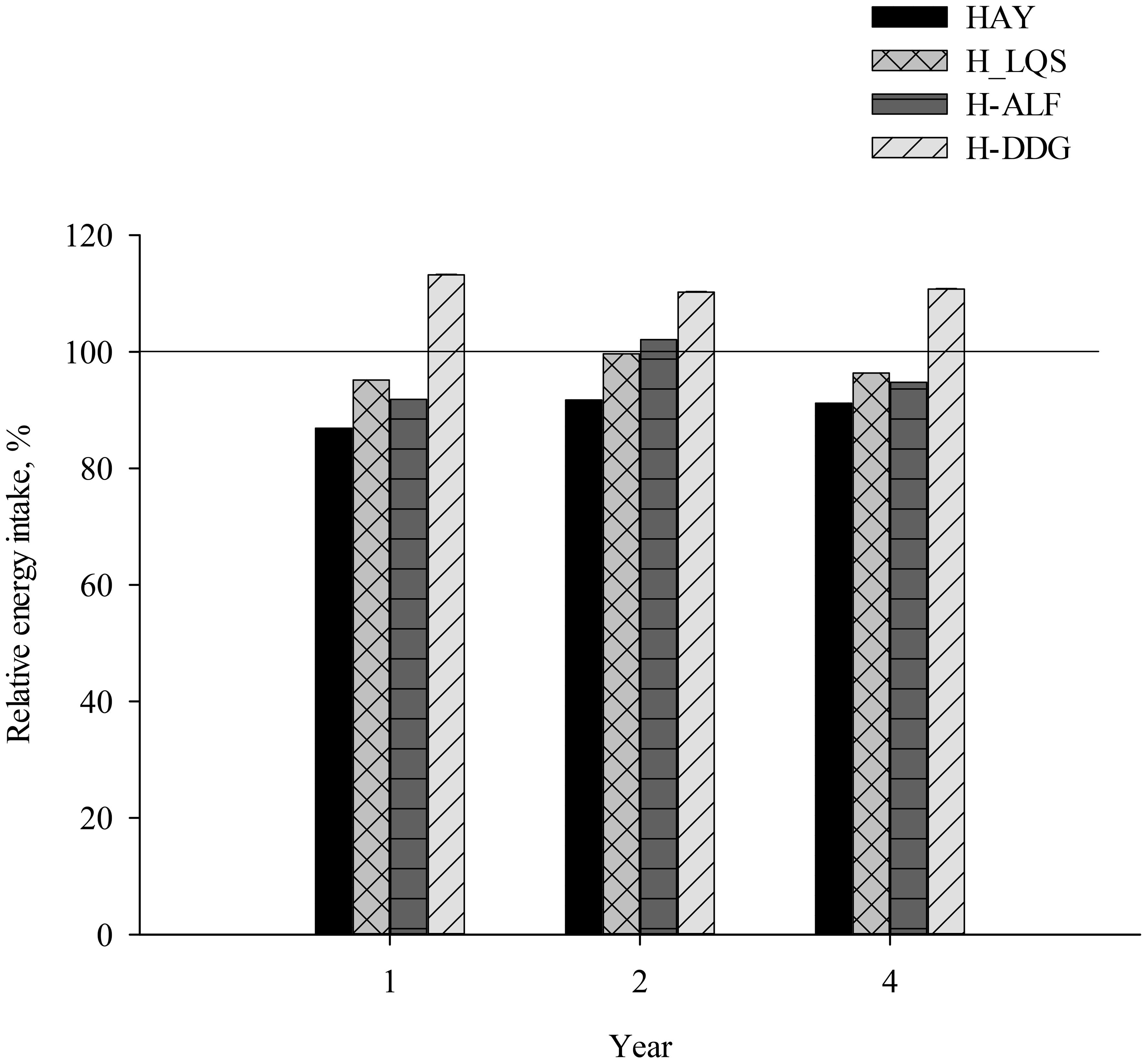
Figure 5. Relative energy intake (%) in cattle grazing grass hay (HAY) or liquid-treated grass hay (H-LQS), grass hay plus alfalfa hay (H-ALF), or grass hay plus corn DDGS (H-DDG). Horizontal line represents year 3 liquid supplement energy intake (baseline).
Supplementation with alfalfa hay supplied MP on excess of cow requirements in all environmental conditions encountered (Figure 3). Supplementation with alfalfa hay improved cow daily gains during mild winters but did not provide adequate energy to meet requirements in cold winters such as occurred in year 1. The 2016 NASEM model showed that alfalfa hay supplied adequate energy only during mild years but not in years with moderate or severe environmental temperatures (Figure 4). In mild environmental temperatures (year 2), alfalfa hay supplementation was nearly as effective as liquid supplementation in providing energy to meet cow energy requirements (Figure 5). Although alfalfa hay can effectively meet CP requirements in rations with low-quality roughages, alfalfa hay does not have the caloric density of oilseed meals or other by-product feeds to meet energy needs (DelCurto et al., 2000). In fact, the energy density of alfalfa is similar to that of high-quality grass hay. Thus, if cows are energy-deficient and marginal in body condition, supplements with higher energy density may be more appropriate (DelCurto et al., 2000). Previous studies (Vanzant and Cochran, 1994; Horney et al., 1996; Weder et al., 1999) have reported improved animal performance when cattle grazing low-quality forage were offered higher-quality alfalfa hay. In practical terms, alfalfa hay as a supplement for beef cattle bale grazing grass hay may be an option in mild winters. In cold winters, higher energy supplements such as corn DDGS and other grains may be required to meet nutritional requirements.
Supplementation with corn DDGS resulted in the highest increase in diet CP and supplied the highest of amount of MP to cows across the years (Figure 3). The high dietary energy resulting from supplementation with DDGS resulted with a diet that exceeded requirements of dry cows. Based on the 2016 NASEM model, feeding 1.8 kg corn DDGS/head/day to cows bale grazing grass hay supplied energy in excess of cow requirements at all environmental temperatures encountered in this study (Figure 4). Compared to year 3 liquid supplementation as a baseline, supplementation with DDGS supplied energy that exceeded cow energy requirements even in years with severe environmental temperatures (Figure 5). As a supplement, corn DDGS compares favorably with other supplements such as soybean meal and canola meal since corn DDGS is a good source of protein, fat, phosphorus, and readily digestible fiber (Klopfenstein et al., 2008). The low starch content of corn DDGS makes corn DDGS a suitable as supplement for grazing cattle (Klopfenstein et al., 2008). Benefits of supplementing cattle on pasture with corn DDGS have been reported in other studies (Wilson et al., 2015; Lardner et al., 2018; Smith et al., 2020). Among the supplements evaluated, corn DDGS is the only supplement that supplied adequate energy for pregnant beef cows that were bale grazing in all environmental conditions encountered in this study.
Animal response to supplementation was influenced by treatment as well as environmental conditions in different years. This response was clearly demonstrated by changes in ADG due to supplementation strategy and environmental temperatures over the four-year period. Environmental conditions can have a significant effect on variation in supplement intake by grazing beef cattle consuming a protein supplement in winter (Wyffels et al., 2020). Supplementation strategies successfully improved animal gains in more favorable environmental conditions such as those in year 2. In more inclement weather conditions, corn DDGS supplementation was more effective in maintaining or improving animal gains.
Supplementation costs ranged from $1.33 to $1.90/head/day for different strategies (Table 5). Predictably, bale grazing grass hay alone resulted in the lowest system costs. Minimizing use of purchased hay, transportation costs, and grazing hay bales in the field from which the hay was baled would keep costs of bale grazing low. Liquid supplementation increased grazing costs by $0.26/head/day over grass hay due to the cost of the liquid supplement. Supplementation with alfalfa hay increased costs by $0.25/head/day over grass hay (Table 5). The highest cost ($1.90/head/day), occurred when corn DDGS was offered as a supplement mainly due to the cost of corn DDGS as well as labor required for twice-weekly visits to deliver corn DDGS to cattle on pasture. Limiting delivery frequency to one visit per week would reduce the cost of corn DDGS supplementation.
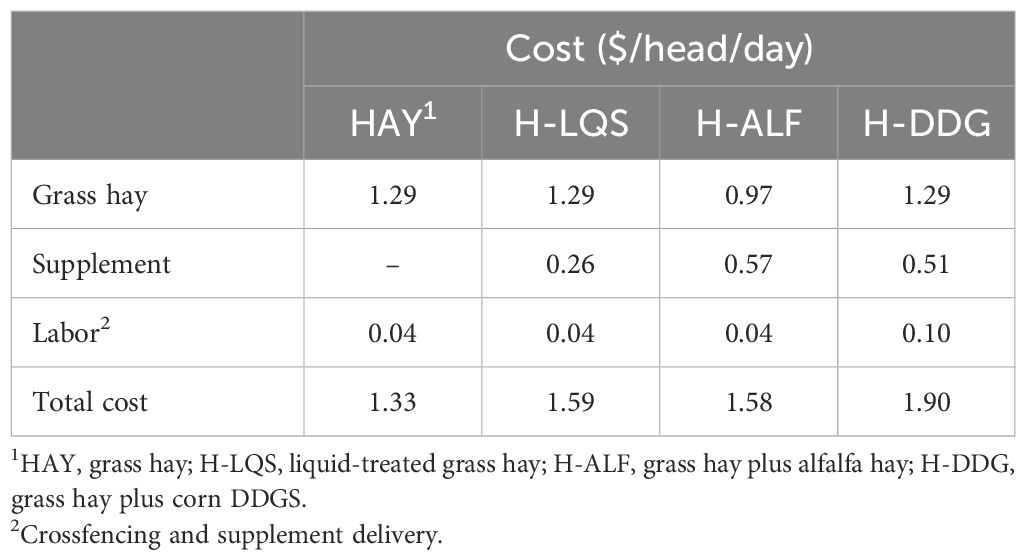
Table 5. Cost comparison following bale grazing of grass hay, or grass hay supplemented with a liquid, alfalfa hay, or corn DDGS.
5 Conclusion
Alfalfa hay or molasses-based liquids may be utilized as supplements during mild winters but severely cold winters require higher energy supplements such as corn DDGS. Despite the relatively higher cost, supplementation with corn DDGS may be required in situations such as severe winters where cattle require extra energy to maintain or improve performance. Supplement selection should consider supplement effectiveness to meet animal nutrient requirements particularly in adverse winter conditions such as those encountered in the US Northern Great Plains.
Data availability statement
The raw data supporting the conclusions of this article will be made available by the authors, without undue reservation.
Ethics statement
The animal study was approved by North Dakota State Animal Care &Use Committee (IACUC). The study was conducted in accordance with the local legislation and institutional requirements.
Author contributions
MU: Conceptualization, Data curation, Formal analysis, Funding acquisition, Investigation, Methodology, Project administration, Resources, Software, Supervision, Validation, Visualization, Writing – original draft, Writing – review & editing. KS: Conceptualization, Funding acquisition, Investigation, Writing – review & editing, Writing – original draft. JB: Data curation, Investigation, Methodology, Writing – review & editing, Writing – original draft.
Funding
The author(s) declare financial support was received for the research, authorship, and/or publication of this article. This work was supported by North Dakota State University, Central Grasslands Research Extension Center Hatch Project (ND06152).
Acknowledgments
We thank the late Rodney Schmidt, the late Dwight Schmidt, as well as Stephanie Becker, Scott Alm, Tim Long, Cody Wieland, Thomas Mittleider, and Rick Bohn for technical assistance. Special thanks to QLF personnel, Tom Lere and Curt Lahr, for technical support and to QLF for partial support through a reduced (research) price for Range-40. We also thank Janet Patton for reviewing this manuscript.
Conflict of interest
The authors declare that the research was conducted in the absence of any commercial or financial relationships that could be construed as a potential conflict of interest.
Publisher’s note
All claims expressed in this article are solely those of the authors and do not necessarily represent those of their affiliated organizations, or those of the publisher, the editors and the reviewers. Any product that may be evaluated in this article, or claim that may be made by its manufacturer, is not guaranteed or endorsed by the publisher.
References
Abney C. S., Galyean M. L. (2006). Seasonal and environmental effects on energy requirements and performance of high-producing cattle. Mid-South Ruminant Nutr. Conf., 43–50. Available online at: https://www.txanc.org/Proceedings/2006/Abney-manuscript-final.pdf.
Alemu A. W., Doce R. R., Dick A. C., Basarab J. A., Kröbel R., Haugen-Kozyra K., et al. (2016). Effect of winter feeding systems on farm greenhouse gas emissions. Agric. Syst. 148, 28–37. doi: 10.1016/j.agsy.2016.06.008
Asem-Hiablie S., Rotz C. A., Stout R., Stackhouse-Lawson K. (2016). Management characteristics of beef cattle production in the Northern Plains and Midwest regions of the United States. Prof. Anim. Sci. 32, 736–749. Available at: https://www.appliedanimalscience.org/action/showPdf?pii=S1080-7446%2816%2930082-1.
Association of Official Analytical Chemists (AOAC) (2005). Official methods of analysis (Arlington, VA: AOAC).
Bernier J. N., Undi M., Ominski K. H., Donohoe G., Tenuta M., Flaten D., et al. (2014). Nitrogen and phosphorus utilization and excretion by beef cows fed a low-quality forage diet supplemented with dried distillers’ grains with solubles under thermal neutral and prolonged cold conditions. Anim. Feed Sci. Technol. 193, 9–20. doi: 10.1016/j.anifeedsci.2014.03.010
Cappellozza B. I., Bohnert D. W., Schauer C. S., Falck S. J., Vanzant E. S., Harmon D. L., et al. (2013). Daily and alternate day supplementation of urea or soybean meal to ruminants consuming low-quality cool-season forage: II. Effects on ruminal fermentation. Livest. Sci. 155, 214–222. doi: 10.1016/j.livsci.2013.05.002
DelCurto T., Cochran R. C., Nagaraja T. G., Corah L. R., Beharka A. A., Vanzant E. S. (1990). Comparison of soybean meal/sorghum grain, alfalfa hay and dehydrated alfalfa pellets as supplemental protein sources for beef cattle consuming dormant tallgrass-prairie forage. J. Anim. Sci. 68, 2901–2915. doi: 10.2527/1990.6892901x
DelCurto T., Hess B. W., Huston J. E., Olson K. C. (2000). Optimum supplementation strategies for beef cattle consuming low-quality roughages in the western United States. J. Anim. Sci. 77, 1–16. doi: 10.2527/jas2000.77E-Suppl1v
Fox D. G., Sniffen C. J., O’Connor J. D. (1988). Adjusting nutrient requirements of beef cattle for animal and environmental variations. J. Anim. Sci. 66, 1475–1495. doi: 10.2527/jas1988.6661475x
Horney M. R., DelCurto T., Stamm M. M., Bailey R. K., Brandyberry S. D. (1996). Early-vegetative tall fescue hay versus alfalfa hay as a supplement for cattle consuming low-quality roughages. J. Anim. Sci. 74, 1959–1966. doi: 10.2527/1996.7481959x
Jaderborg J. P., Bird S. L., Crawford G. I., Walker R. S., DiCostanzo A. (2021). Influence of hay feeding method, supplement moisture, or access time on intake and waste by beef cows. Transl. Anim. Sci. 5, 1–11. doi: 10.1093/tas/txab069
Jungnitsch P., Schoenau J. J., Lardner H. A., Jefferson P. G. (2011). Winter feeding beef cattle on the western Canadian prairies: impacts on soil nitrogen and phosphorous cycling and forage growth. Agric. Ecosyst. Environ. 141, 143–152. doi: 10.1016/j.agee.2011.02.024
Kelln B. M., Lardner H. A., McKinnon J. J., Campbell J. R., Larson K., Damiran D. (2011). Effect of winter-feeding system on beef cow performance, reproductive efficiency, and system cost. Prof. Anim. Sci. 27, 410–421. doi: 10.15232/S1080-7446(15)30513-1
Klopfenstein T. J., Ericson G. E., Bremer V. R. (2008). Board invited review: Use of distillers by-products in the beef cattle feeding industry. J. Anim. Sci. 86, 1223–1231. doi: 10.2527/jas.2007-0550
Lardner H. B., Larson K., Christensen D. A., McKinnon J. J., Añez-Osuna F., Damiran D., et al. (2018). Performance of stocker cattle grazing bales in winter and supplemented with wheat-based dried distillers grains plus solubles or barley grain in western Canada. Prof. Anim. Sci. 34, 460–468. doi: 10.15232/pas.2018-01723
Loy T. W., MacDonald J. C., Klopfenstein T. J., Erickson G. E. (2007). Effect of distillers grains or corn supplementation frequency on forage intake and digestibility. J. Anim. Sci. 85, 2625–2630. doi: 10.2527/jas.2005-750
Manoukian M., DelCurto T., Kluth J., Carlisle T., Davis N., Nack M., et al. (2021). Impacts of rumen degradable or undegradable protein supplementation with or without salt on nutrient digestion, and VFA concentrations. Animals. 11, 3011. doi: 10.3390/ani11113011
McGeough E. J., Cattani D. J., Koscielny Z., Hewitt B., Ominski K. H. (2018). Annual and perennial forages for fall/winter grazing in western Canada. Can. J. Plant Sci. 98247–254. doi: 10.1139/cjps-2017-0228
NASEM (2016). Nutrient requirement of beef cattle. 8th rev. ed (Washington, DC: Natl. Acad. Press). doi: 10.17226/19014
North Dakota Agricultural Weather Network (2021). Available online at: https://ndawn.ndsu.nodak.edu/ (Accessed June 22, 2022).
Rasby R. J., Stalker A., Funston R. N. (2014).Body condition scoring beef cows: A tool for managing the nutrition program for beef herds. Available online at: https://extensionpublications.unl.edu/assets/pdf/ec281.pdf (Accessed February 17, 2019).
Schauer C. S., Bohnert D. W., Ganskopp D. C., Richards C. J., Falck S. J. (2005). Influence of protein supplementation frequency on cows consuming low-quality forage: performance, grazing behavior, and variation in supplement intake. J. Anim. Sci. 83, 1715–1725. doi: 10.2527/2005.8371715x
Smith W. B., Banta J. P., Forster J. L., Redmon L. A., MaChado T. J., Tedeschi L. O., et al. (2020). Evaluation of growth performance and carcass characteristics of beef stocker cattle grazing Tifton 85 Bermudagrass supplemented with dried distiller’s grains with solubles then finished in the feedlot. App. Anim. Sci. 36, 308–319. doi: 10.15232/aas.2019-01907
U.S. Department of Agriculture, Natural Resources Conservation Service (NRCS) (2021). Soil web survey. 2021. Available online at: https://websoilsurvey.sc.egov.usda.gov/App/HomePage.htm (Accessed October 20, 2021).
Vanzant E. S., Cochran R. (1994). Performance and forage utilization by beef cattle receiving increasing amounts of alfalfa hay as a supplement to low-quality, tallgrass-prairie forage. J. Anim. Sci. 72, 1059–1067. doi: 10.2527/1994.7241059x
Villalobos G., Adams D. C., Klopfenstein T. J., Nichols J. T., Lamb J. B. (1997). Grass hay as a supplement for grazing cattle: I. Animal performance. J. Range Manage. 50, 351–356. doi: 10.2307/4003298
Walker R. S., LaMay D., Davis J. R., Bandyk C. (2013). Method of feeding a liquid protein supplement with low- to medium-quality hay affects hay waste and cow performance. Prof. Anim. Sci. 29, 552–558. doi: 10.15232/S1080-7446(15)30277-1
Warner J. M., Schneider C. J., Erickson G. E., Klopfenstein T. J., Rasby R. J. (2015). Applying corn condensed distillers solubles to hay windrows before baling: effects on bale temperature, nutrient composition, and growing steer-calf performance. Prof. Anim. Sc. 31, 207–215. doi: 10.15232/pas.2014-01354
Weder C. E., DelCurto T., Svejcar T., Jaeger J. R., Bailey R. K. (1999). Influence of supplemental alfalfa quality on the intake, use, and subsequent performance of beef cattle consuming low-quality roughages. J. Anim. Sci. 77, 1266–1276. doi: 10.2527/1999.7751266x
Wickersham T. A., Titgemeyer E. C., Cochran R. C., Wickersham E. E., Moore E. S. (2008). Effect of frequency and amount of rumen-degradable intake protein supplementation on urea kinetics and microbial use of recycled urea in steers consuming low-quality forage. J. Anim. Sci. 86, 3089–3099. doi: 10.2527/jas.2007-0326
Wilson T. B., Schroeder A. R., Ireland F. A., Faulkner D. B., Shike D. W. (2015). Effects of late gestation distillers’ grains supplementation on fall-calving beef cow performance and steer calf growth and carcass characteristics. J. Anim. Sci. 93, 4843–4851. doi: 10.2527/jas.2015-9228
Keywords: bale grazing, grass hay, supplementation, alfalfa hay, corn DDGS, liquid supplement
Citation: Undi M, Sedivec K and Bachler J (2024) Assessing supplementing strategies for beef cattle in a bale grazing system using grass hay during variable winter conditions. Front. Anim. Sci. 5:1415622. doi: 10.3389/fanim.2024.1415622
Received: 10 April 2024; Accepted: 08 August 2024;
Published: 27 August 2024.
Edited by:
James Levi Klotz, United States Department of Agriculture, United StatesReviewed by:
Alfredo DiCostanzo, University of Nebraska-Lincoln, United StatesMatt Akins, Agricultural Research Service (USDA), United States
Copyright © 2024 Undi, Sedivec and Bachler. This is an open-access article distributed under the terms of the Creative Commons Attribution License (CC BY). The use, distribution or reproduction in other forums is permitted, provided the original author(s) and the copyright owner(s) are credited and that the original publication in this journal is cited, in accordance with accepted academic practice. No use, distribution or reproduction is permitted which does not comply with these terms.
*Correspondence: Michael Undi, bWljaGFlbC51bmRpQG5kc3UuZWR1
 Michael Undi
Michael Undi Kevin Sedivec
Kevin Sedivec Jessalyn Bachler3
Jessalyn Bachler3
